Cobicistat/darunavir/emtricitabine/tenofovir alafenamide and Alcohol/Food Interactions
There are 2 alcohol/food/lifestyle interactions with cobicistat / darunavir / emtricitabine / tenofovir alafenamide.
Darunavir Food/Lifestyle
Moderate Food Interaction
Consumer information for this interaction is not currently available.
ADJUST DOSING INTERVAL: Food enhances the absorption and oral bioavailability of darunavir administered in combination with low-dose ritonavir. The mechanism is unknown. When administered with food, the peak plasma concentration (Cmax) and area under the plasma concentration-time curve (AUC) of darunavir were approximately 30% higher than when administered in the fasting state. Darunavir exposure was similar for the range of meals studied. The total caloric content of the various meals evaluated ranged from 240 Kcal (12 grams fat) to 928 Kcal (56 grams fat).
MANAGEMENT: To ensure maximal oral absorption, darunavir coadministered with ritonavir should be taken with food. The type of food is not important.
Tenofovir Food/Lifestyle
Minor Food Interaction
Information for this minor interaction is available on the professional version.
Switch to professional interaction data
Cobicistat/darunavir/emtricitabine/tenofovir alafenamide drug interactions
There are 783 drug interactions with cobicistat / darunavir / emtricitabine / tenofovir alafenamide.
Cobicistat/darunavir/emtricitabine/tenofovir alafenamide disease interactions
There are 11 disease interactions with cobicistat / darunavir / emtricitabine / tenofovir alafenamide which include:
- hepatotoxicity
- hepatitis B
- hepatotoxicity
- creatinine clearance
- hemodialysis
- renal dysfunction
- hemophilia
- hyperglycemia
- bone toxicity
- liver disease
- renal dysfunction
More about cobicistat / darunavir / emtricitabine / tenofovir alafenamide
- cobicistat/darunavir/emtricitabine/tenofovir alafenamide consumer information
- Check interactions
- Compare alternatives
- Reviews (9)
- Side effects
- Dosage information
- During pregnancy
- Drug class: antiviral combinations
- En español
Related treatment guides
Drug Interaction Classification
| Highly clinically significant. Avoid combinations; the risk of the interaction outweighs the benefit. | |
| Moderately clinically significant. Usually avoid combinations; use it only under special circumstances. | |
| Minimally clinically significant. Minimize risk; assess risk and consider an alternative drug, take steps to circumvent the interaction risk and/or institute a monitoring plan. | |
| No interaction information available. |
See also:
Further information
Always consult your healthcare provider to ensure the information displayed on this page applies to your personal circumstances.


